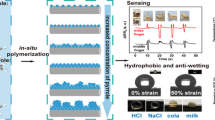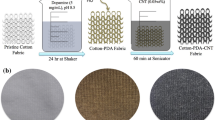Abstract
A simple but effective method of developing multifunctional wearable cotton fabrics was achieved via screen printing of carbon nanotube (CNT) ink on one side of a weft knitted cotton fabrics. Scanning electron microscopy was employed to investigate the morphology of the CNT/Cotton Composite fabric (CCCF). The deposition of conductive CNT paste has brought electric conductivity (50.75 Ω/sq) to CCCF. The electromechanical performance of the CCCF was evaluated, and the CCCF showed great stability and flexibility in terms of strain sensing. The CCCF was demonstrated to sense different human activities such as speaking, drinking, writing, and bending of finger and wrist. The developed CCCF also exhibited excellent electrothermal performance with the potential to be used as an electric heater. Color changing performance was generated by screen printing thermochromic inks on the back side of CCCF. The flexible strain sensors, electric heaters, and color-changing textiles made from CCCF are promising candidates as smart textiles to be used as wearable electronic devices, cold weather conditioners, and smart displays.







Similar content being viewed by others
References
Alimohammadi F et al (2013) Functional cellulose fibers via polycarboxylic acid/carbon nanotube composite coating. J Coat Technol Res 10(1):123–132
Arapov K et al (2016) Conductive screen printing inks by gelation of graphene dispersions. Adv Funct Mater 26(4):586–593
Choi C et al (2018) Weavable asymmetric carbon nanotube yarn supercapacitor for electronic textiles. RSC Adv 8(24):13112–13120
Das C, Krishnamoorthy K (2016) Flexible microsupercapacitors using silk and cotton substrates. ACS Appl Mater Interfaces 8(43):29504–29510
Denneulin A et al (2011) Substrate pre-treatment of flexible material for printed electronics with carbon nanotube based ink. Appl Surf Sci 257(8):3645–3651
Di J et al (2016) Carbon-nanotube fibers for wearable devices and smart textiles. Adv Mater 28(47):10529–10538
Gao N et al (2019) Crystal-confined freestanding ionic liquids for reconfigurable and repairable electronics. Nat Commun 10(1):547
Govaert F, Vanneste M (2014) Preparation and application of conductive textile coatings filled with honeycomb structured carbon nanotubes. J Nanomater 2014:13
Gui Q et al (2017) A skin-inspired integrated sensor for synchronous monitoring of multiparameter signals. Adv Funct Mater 27(36):1702050
He Y et al (2015) A self-healing electronic sensor based on thermal-sensitive fluids. Adv Mater 27(31):4622–4627
He X et al (2017) Transparent electrode based on silver nanowires and polyimide for film heater and flexible solar cell. Materials 10(12):1362
Hong S et al (2015) Highly stretchable and transparent metal nanowire heater for wearable electronics applications. Adv Mater 27(32):4744–4751
Hyun WJ et al (2015) High-resolution patterning of graphene by screen printing with a silicon stencil for highly flexible printed electronics. Adv Mater 27(1):109–115
Ilanchezhiyan P et al (2015) Highly efficient CNT functionalized cotton fabrics for flexible/wearable heating applications. RSC Adv 5(14):10697–10702
Jang J et al (2017) Rapid production of large-area, transparent and stretchable electrodes using metal nanofibers as wirelessly operated wearable heaters. NPG Asia Mater 9(9):e432
Jia H et al (2015) Integrating ultra-thermal-sensitive fluids into elastomers for multifunctional flexible sensors. Adv Electron Mater 1(3):1500029
Ko Y et al (2017) Flexible supercapacitor electrodes based on real metal-like cellulose papers. Nat Commun 8(1):536
Koo H et al (2015) Scalability of carbon-nanotube-based thin film transistors for flexible electronic devices manufactured using an all roll-to-roll gravure printing system. Sci Rep 5:14459
Krucińska I et al (2011) The use of carbon nanotubes in textile printing. J Appl Polym Sci 121(1):483–490
Krucinska I et al (2014) Printed textiles with chemical sensor properties. Fibre Text East Euro 22(4):68
Lee J et al (2015a) Conductive fiber-based ultrasensitive textile pressure sensor for wearable electronics. Adv Mater 27(15):2433–2439
Lee W et al (2015b) A fully roll-to-roll gravure-printed carbon nanotube-based active matrix for multi-touch sensors. Sci Rep 5:17707
Li Y-Q et al (2017) Flexible wire-shaped strain sensor from cotton thread for human health and motion detection. Sci Rep 7:45013
Li X et al (2018) Wearable strain sensing textile based on one-dimensional stretchable and weavable yarn sensors. Nano Res 11(11):5799
Metters JP et al (2011) New directions in screen printed electroanalytical sensors: an overview of recent developments. Analyst 136(6):1067–1076
Nuramdhani I et al (2018) Electrochemical impedance analysis of a PEDOT: PSS-based textile energy storage device. Materials 11(1):48
Park JJ et al (2015) Highly stretchable and wearable graphene strain sensors with controllable sensitivity for human motion monitoring. ACS Appl Mater Interfaces 7(11):6317–6324
Shen C et al (2017) Wearable woven supercapacitor fabrics with high energy density and load-bearing capability. Sci Rep 7(1):14324
Shengbo S et al (2018) Highly sensitive wearable strain sensor based on silver nanowires and nanoparticles. Nanotechnology 29(25):255202
Song JW, Kim YS, Yoon YH, Lee ES, Han C-S, Cho Y, Kim D, Kim J, Lee N, Ko YG, Jung HT, Kim SH (2009) The production of transparent carbon nanotube field emitters using inkjet printing. Phys E Low Dimens Syst Nanostruct 42(8):1513–1516
Wang L-L et al (2009) Electromagnetic interference shielding effectiveness of carbon-based materials prepared by screen printing. Carbon 47(8):1905–1910
Wang R et al (2010) Microstructures and electrical conductance of silver nanocrystalline thin films on flexible polymer substrates. Surf Coat Technol 204(8):1206–1210
Yang M et al (2018) Conductive cotton fabrics for motion sensing and heating applications. Polymers 10(6):568
Zahid M et al (2017) Strain-responsive mercerized conductive cotton fabrics based on PEDOT: PSS/graphene. Mater Des 135:213–222
Zhang M et al (2017) Weft-knitted fabric for a highly stretchable and low-voltage wearable heater. Adv Electron Mater 3(9):1700193
Acknowledgments
This research was supported by the National Natural Science Foundation of China (NSFC 51503164 and 51403162).
Author information
Authors and Affiliations
Corresponding authors
Additional information
Publisher's Note
Springer Nature remains neutral with regard to jurisdictional claims in published maps and institutional affiliations.
Electronic supplementary material
Below is the link to the electronic supplementary material.
Rights and permissions
About this article
Cite this article
Sadi, M.S., Yang, M., Luo, L. et al. Direct screen printing of single-faced conductive cotton fabrics for strain sensing, electrical heating and color changing. Cellulose 26, 6179–6188 (2019). https://doi.org/10.1007/s10570-019-02526-6
Received:
Accepted:
Published:
Issue Date:
DOI: https://doi.org/10.1007/s10570-019-02526-6




